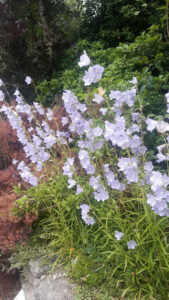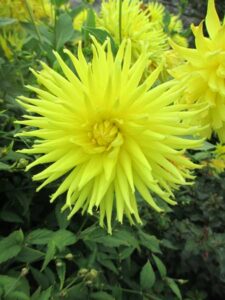Gardening
with Charlie Wilkins
SEASONAL CHANGES
Trees will soon undress, their accessories will totter and twist to begin, then eventually fall to the sodden ground in a slow, liquid fashion. They will litter in the process, ending up in corners and under shrubs and around ornamental pots. Those who do not garden will either let them be or begrudgingly sweep them up for disposal in rubbish bins. What a waste of valuable litter! Gardeners will compost these.
Beyond the garden boundary, a long line of ash trees is visible, their colouring now a vivid yellow. Overnight it would seem, the blue has drained from the leaves leaving yellow on its own as a ghostly reminder of a summer that was drier and warmer than normal. When the wind next reaches gale force, these will be wrenched from their stalks and blown far from their source.
Leaf fall is but the beginning and vegetation of every kind will soon start to decay. There are those who advocate leaving these visible signs of decay, but I much prefer the total gathering and clearance of redundant plant material for its perfect as fodder for the now expanding compost heap! An exception every year is the saving of a few well-tended fibrous rooted Begonia semperflorens. These will be lifted, gently cleaned, and then shortened in stem so that they can be potted into small brightly coloured pots to be stood on the windowsills indoors. Here, given careful watering and occasional liquid feeding, they will bloom away happily until spring.
What great value these ‘summer bedding begonias’ plants are year after year, for they always come up to expectations irrespective of the weather. Most other annuals (with a few notable exceptions) sulk and enter fits of pique when conditions become damp and light levels remain poor! Note these for next year I urge.Begonia semperflorens make compact plants with light green leaves, (sometimes bronze) covered in small red, pink, or white flowers throughout summer. Irrespective of rain and lack of sun these will bloom away uninterrupted, and quite content, even in poor soil and north-facing shady situations. The ‘Coctail Series’ of a decade ago are still proving very satisfactory in wet (and drought) conditions, and the seed companies, knowing this, continue to breed and trial ever more reliable strains.
It is also not surprising that their cousins, the large-flowered tuberous begonias have also become increasingly popular as bedding plants. These, like semperflorens are tender plants which even a slight frost will cut to the ground, but until then, they’ll continue to bloom with vitality and passion. No harm will come to the tubers tucked safely beneath the soil but by late October it will be time to lift these and to begin the process of drying and storage. Simply lift the tubers having first cut away all but an inch or so of the soft stem. Allow the tubers to dry on a concrete surface for about a week then shake off the excess soil and scrub away the stub of the remaining stem. Then, store in boxes of dry potting compost in a frost-free garage or shed inspecting them regularly for signs of rot.

OCTOBER JOTTINGS
By early October things in the garden begin to look a little fazed! Though still colourful our garden has started to visibly sag, and each day the dew seems to linger longer and fall earlier. Dawn stays at its post longer, and the wings of evening arrive earlier and earlier. From shortly after mid-month, when the clocks go back, the changes will be even more evident. Darkness will reign for longer and temperatures continue to drop. I have never been comfortable with darkness at 4pm.
The garden will then return to a state of intimacy once more, and the two of us are happy to rest temporarily. No matter how much gardeners try to tame autumn and winter, they will not succeed for nature will not be brought to heel!
SPIDERS
Spiders continue to dominate the scene as the days grow ever shorter. Cobwebs are seen draped from every shrub and rose, so wet and white in the pale morning mist that they sometimes look like tatty linen spread out to dry. The orb spider with its huge pregnant bump and dark cross-like outline on its back is responsible for these woven wonders, but they had better move into more sheltered positions soon, for wind and rain will daily destroy their handiwork as surely as frost on dahlias.
MISTY BLUES
October is the time when tawny colours glow rather than blaze and misty blues seems the right colour for the passing of the seasons. I have a few favourites and you have heard of some in the past. Top of my list is Aster cordifolius ‘Little Carlow’. This never gets mildew, and even though it makes a fine strong plant you must not divide it now. Wait for spring at which time you can lift, divide and replant. Chrysanthemums fall into the same bracket!
DAHLIAS NEED NAMING
There’s an aspect to the culture of dahlias which I feel I should mention this week and that is, the labelling of each variety as they are cut down prior to drying at month’s end. I often fail to do this myself and when the different varieties are lifted and grouped together, it is impossible to determine which is which. So, tie a label to each stem low down so that the plants can be easily identified at planting time next year. Be sure to include name, colour, variety (cactus, decorative, ball, pom-pom, etc) and the height at which they flower.







